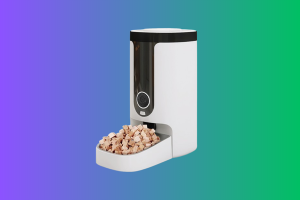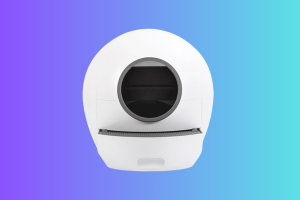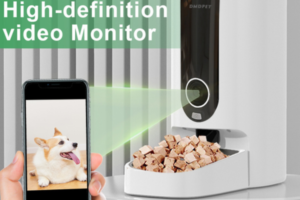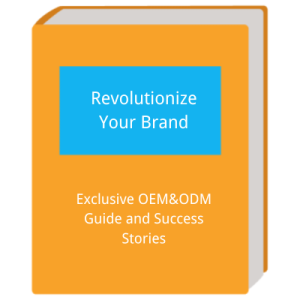Choosing the right cat litter is crucial for keeping you and your cat happy. So many options are available, from clumping cat litter to non-clumping litter and clay litter to crystal litter. Selecting the best cat litter for your feline friend can be overwhelming.
The type of cat litter you choose can significantly impact how often you need to clean the box, how well odors are controlled, and your cat’s health and happiness. In this comprehensive guide, we’ll dive deep into the important role of litter in a cat’s life. And help you navigate the various types of cat litter that are available.
Whether you have a kitten or an older cat, we aim to help you choose the right cat litter to keep your litter box clean and your cats purring with satisfaction. Read on to discover the best litter options, from clumping clay litter to innovative crystal litter, and ensure your cat’s litter box is always a welcoming place.
The Main Types Of Cat Litter
Crystal Cat Litter

Crystal cat litter, made from silica gel, is renowned for its superior moisture absorption and odor control capabilities. This litter type is designed to absorb moisture from cat waste, drying it out and trapping odors. It’s a top choice among cat owners seeking convenience and efficiency in managing their kitty litter.
Pros of Crystal Cat Litter
- Superior Odor Control: Effectively traps and neutralizes the smell of cat pee.
- Highly Absorbent: Absorbs moisture quickly, keeping the litter box dry.
- Low Dust: Reduces dust, making it cleaner and healthier for cats and owners.
- Long-Lasting: Typically lasts longer than other litter types, reducing the frequency of litter changes.
Cons of Crystal Cat Litter
- Cost: More expensive compared to other types of cat litter.
- Texture: Some cats may find the texture uncomfortable and refuse to use it.
- Not Biodegradable: Unlike natural options, crystal litter is not eco-friendly.
Applicability
Crystal cat litter is ideal for pet owners, as it prioritizes convenience and odor control. It benefits those with one box and busy schedules, requiring less frequent changes. Consider other options if you have multiple cats or cats with sensitive paws.
The litter you use plays a significant role in your cat’s comfort and ease of cleaning the litter box. Cats prefer a litter that feels comfortable on their paws. Switching to a softer type, like clay cat litter, could be beneficial if your cat rejects crystal litter.
Bentonite Cat Litter

Bentonite cat litter, commonly called clumping clay litter, is popular among cat owners due to its excellent clumping abilities and odor control. This type of litter is made from natural clay, which forms solid clumps when they come into contact with moisture—making it easier to scoop out waste and keep the litter box clean.
Pros of Bentonite Cat Litter
- Excellent clumping ability: It makes scooping out waste and cleaning the litter box easy.
- Superior odor control: Effectively masks the smell of cat pee.
- Widely available: Found in most stores and online.
- Affordable: One of the more cost-effective options on the market.
- Preferred by many cats: The texture resembles natural soil, which cats prefer.
Cons of Bentonite Cat Litter
- Dusty: This can create dust that may be problematic for cats and owners with respiratory issues.
- Not biodegradable: Made from clay, it’s not environmentally friendly.
- Heavy: Can be cumbersome to carry and handle, especially in large quantities.
- Tracking: Can stick to cats’ paws and be tracked outside the box.
Applicability
Bentonite cat litter is ideal for owners looking for an efficient, affordable, and easy-to-clean option. It’s particularly suitable for households with multiple cats. It provides superior odor control and clumping properties, making it easier to manage. If you or your cat have respiratory issues, consider dust-free alternatives.
Environmentally conscious owners may look into more biodegradable options. For those using a self-cleaning litter box, bentonite litter is often compatible. But check your specific model’s requirements. We’ll also provide tips on choosing the right litter for your self-cleaning litter box to ensure optimal performance.
Pine Cat Litter
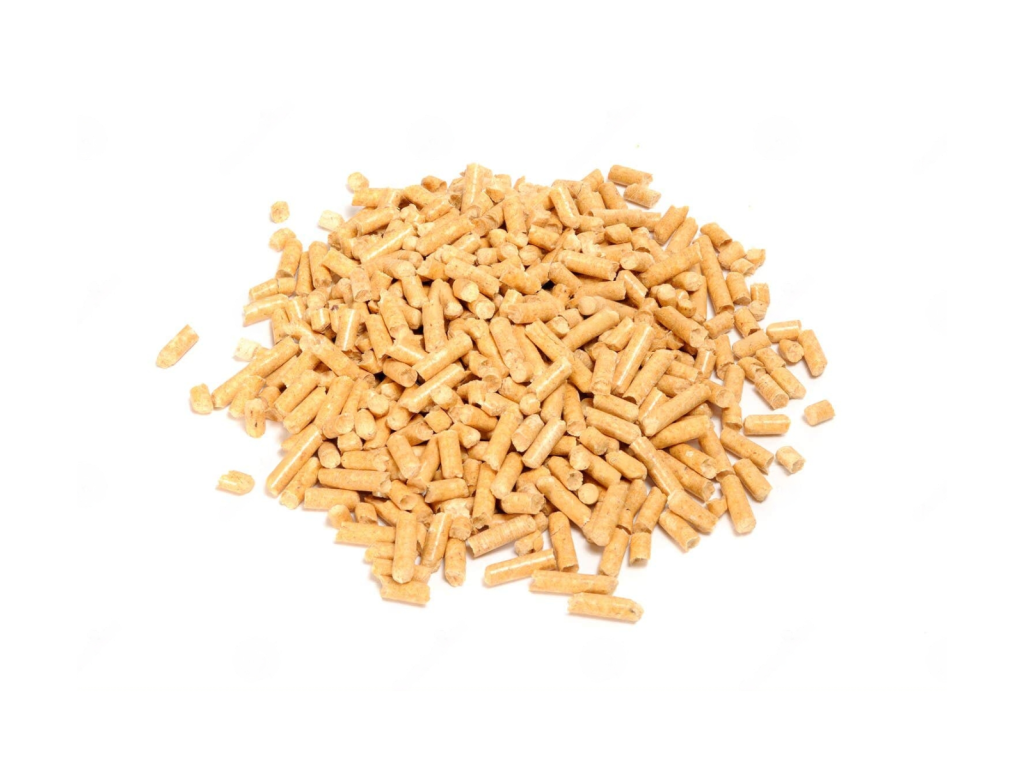
Pine cat litter is a popular eco-friendly choice made from compressed pine wood. It is known for its natural scent and biodegradable properties. That can make it a favorite among environmentally conscious cat owners. Pine litter is available in pellet and granule forms, offering different textures for your cat.
Pros of Pine Cat Litter
- Eco-friendly: Made from natural and biodegradable materials.
- Low dust: Ideal for cats with respiratory issues or allergies.
- Natural scent: The fresh pine scent helps mask the cat pee smell.
- Lightweight: Easier to handle and pour compared to traditional clay litters.
Cons of Pine Cat Litter
- Non-clumping: Requires more frequent changing as it doesn’t form solid clumps.
- Texture: Some cats may not like the feel of pine pellets under their paws.
- Price: It can be more expensive than traditional clay litter.
- Tracking: Pine granules can be tracked outside the box.
Applicability
Pine cat litter is an excellent choice for owners prioritizing sustainability and reducing their environmental footprint. Due to its low dust properties, it’s particularly suitable for households with kittens or cats with respiratory sensitivities. If you prefer a clumping litter for easier scooping, you might find changing the litter more frequently inconvenient.
Paper Cat Litter
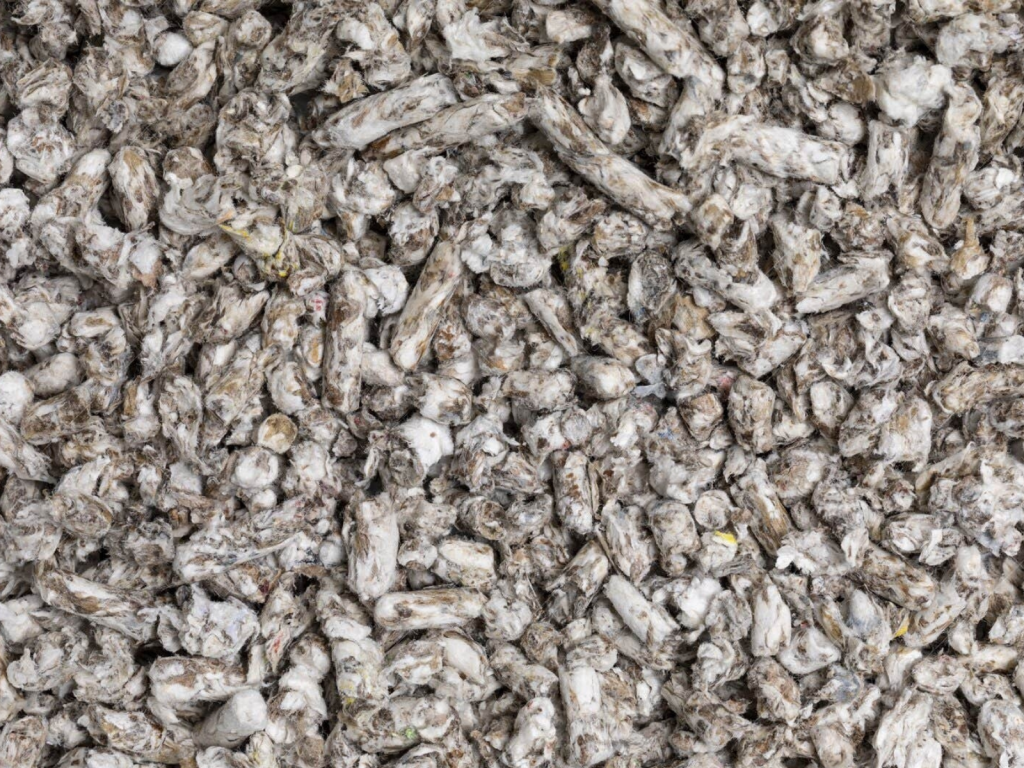
Paper cat litter, crafted from recycled paper, is a unique and environmentally friendly option among the many types of cat litter available on the market. This cat litter is often recommended for cats with respiratory issues or those recovering from surgery. The litter absorbs moisture well and controls odors effectively, making it a practical choice for conscientious cat owners.
Pros of Paper Cat Litter
- Dust-free: Ideal for cats with respiratory issues.
- Soft texture: Gentle on sensitive paws, perfect for kittens and older cats.
- Biodegradable: Environmentally friendly, as it’s made from recycled materials.
- Good odor control: Manages the smell of cat pee effectively.
Cons of Paper Cat Litter
- Non-clumping: Requires frequent changes, making it less convenient.
- Absorption capacity: It may not handle heavy use or other litter.
- Cost: It can be more expensive compared to other types.
Applicability
Paper cat litter is best suited for cats with sensitive paws or respiratory issues, making it an excellent choice for kittens and older cats. Its soft texture ensures that every cat feels comfortable using it. Despite being a non-clumping cat litter. Its strong odor control and eco-friendly nature make it a worthy consideration when choosing cat litter. If convenience and cost are significant factors, you might need to change the litter more frequently, which could add up.
Corn Cat Litter

Corn cat litter is a biodegradable option made from whole-kernel corn. It’s gaining popularity among cat owners who seek an eco-friendly and effective solution for their kitty’s litter box needs. This cat litter offers a unique blend of clumping ability and odor control, making it a contender for the world’s best cat litter.
Pros of Corn Cat Litter
- Biodegradable and Flushable: Environmentally friendly, can be flushed down the toilet.
- Good Clumping Properties: Forms solid clumps for easy scooping.
- Low Dust: Reduces respiratory issues for both cats and humans.
- Lightweight: Easy to carry and pour.
Cons of Corn Cat Litter
- Can Attract Insects: May draw pests like ants or beetles.
- More Expensive: Higher cost compared to traditional clay litter.
- Odor Control May Vary: Not as effective in masking strong odors for extended periods.
Applicability
Corn cat litter is suitable for eco-conscious cat owners who prioritize sustainability and ease of cleaning. Its clumping ability makes it easy to maintain a fresh litter box, which is crucial for keeping the smell of cat pee at bay. This litter is particularly beneficial for households with one or two cats, as it helps maintain cleanliness and minimizes dust.
Tofu Cat Litter
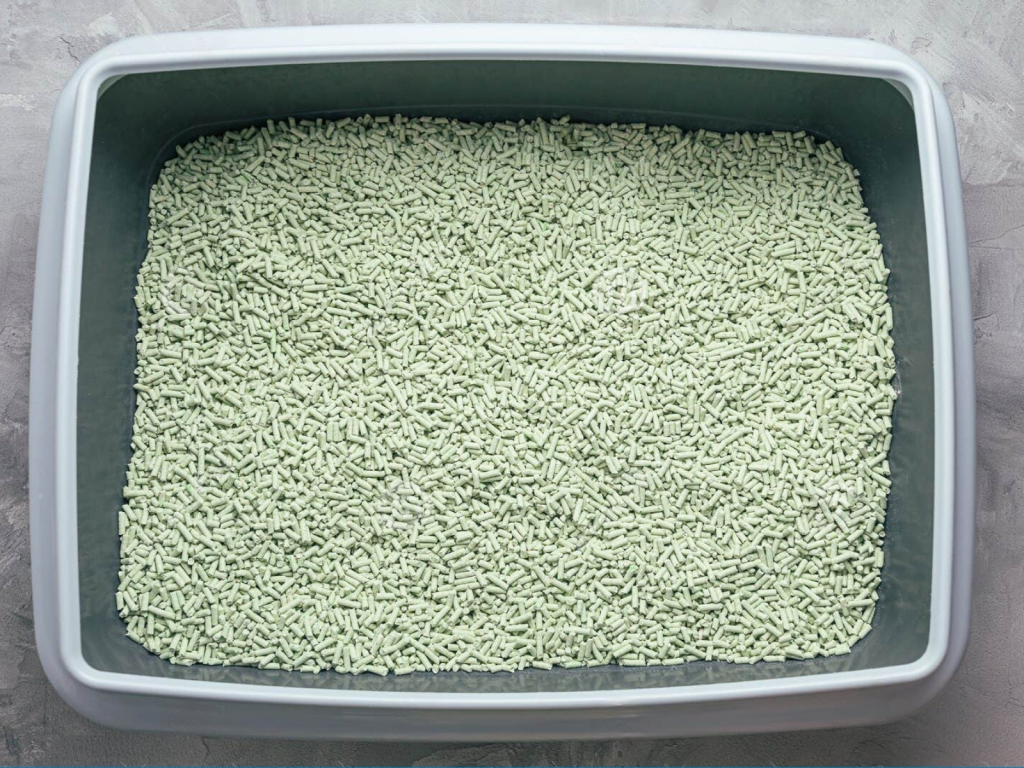
Tofu cat litter is an innovative and eco-friendly option made from soybeans. It’s gaining popularity among cat owners due to its unique properties and sustainability. This kind of litter provides an excellent balance between absorbency and clumping, making it an attractive choice when considering different types of cat litter.
Pros of Tofu Cat Litter:
- Biodegradable: Environmentally friendly and safe to flush.
- Excellent odor control: Neutralizes the smell of cat pee effectively.
- Low dust: Ideal for cats and owners with respiratory issues.
- Soft on paws: Gentle texture, perfect for kittens or sensitive cats.
Cons of Tofu Cat Litter:
- Higher cost: More expensive compared to traditional clay litters.
- Availability: Other cat litter is more widely available.
- Frequent changes needed: More frequent litter box maintenance is required.
Applicability
Tofu cat litter is best suited for cat owners who prioritize sustainability and are willing to invest more in an eco-friendly product. Its soft texture makes it particularly suitable for homes with kittens or cats with sensitive paws. This cat litter is made to be flushable. This is a significant convenience for those who dislike traditional waste disposal. While it may come with a higher price tag and the need for frequent changes.
Mineral Cat Litter
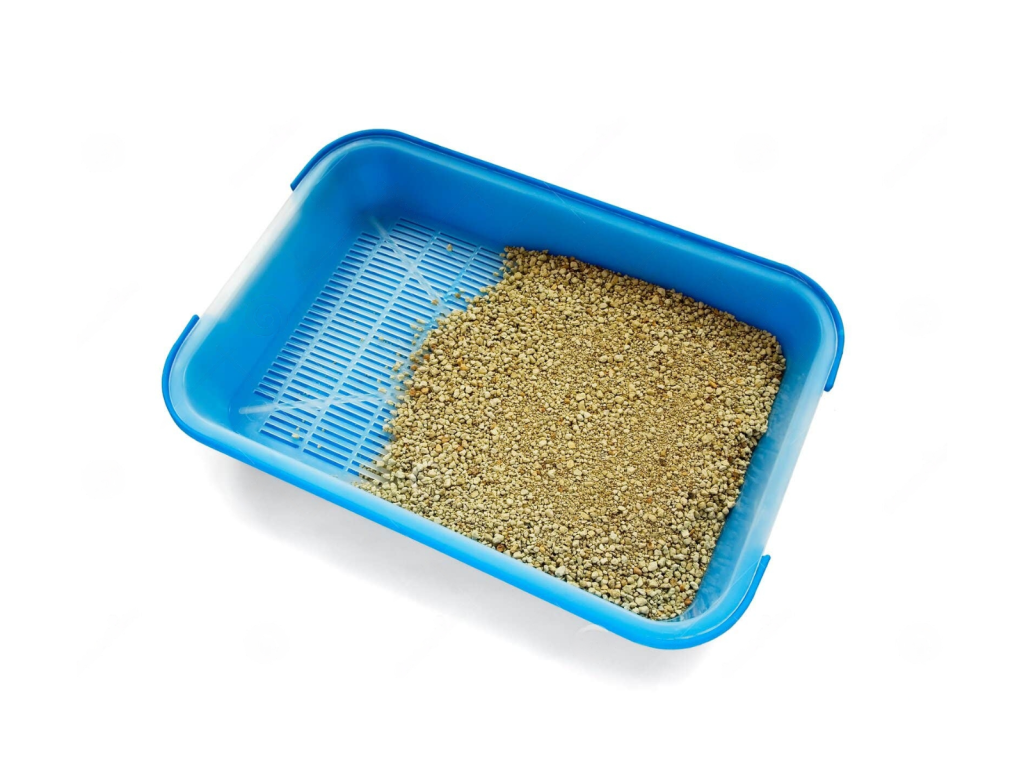
Mineral cat litter is one of the many types available on the market, known for its natural composition and effective absorption. This cat litter is made from natural minerals, providing an excellent alternative for cat owners looking for a non-clumping, highly absorbent option. When it comes to litter, choosing the right type is important to ensure your kitty’s comfort and convenience in maintaining a clean litter box.
Pros of Mineral Cat Litter
- Highly absorbent: Mineral cat litter absorbs moisture effectively, helping to keep the litter box dry.
- Good odor control: It neutralizes the smell of cat pee and other odors, keeping the area fresh.
- Natural and dust-free: Made from natural minerals, it produces little to no dust, which benefits cats and owners with respiratory issues.
- Lightweight: Easier to handle and carry compared to traditional clay cat litter.
Cons of Mineral Cat Litter
- Does not clump: Unlike clumping cat litter, mineral litter does not form clumps, making it harder to remove waste.
- Requires frequent changing: Because it is non-clumping, it must be changed more often to maintain cleanliness.
- Can be more expensive: Mineral cat litter can be pricier than some other types of litter.
Applicability
Mineral cat litter is an excellent choice for owners seeking natural and dust-free litter. It’s particularly suitable for cats with respiratory issues or sensitivities to dust. This type of litter is also a good choice for those who prefer a lightweight option that’s easy to handle. However, it’s important to note that since it does not clump, you must change the litter more frequently to keep the box clean.
Mixed Cat Litter

Mixed cat litter is a blend of different types of cat litter, combining the benefits of materials such as clay, silica, and natural substances. This type of litter aims to offer a balanced solution for odor control, clumping ability, and environmental impact.
Pros of Mixed Cat Litter
- Combines Benefits: Utilizes the best qualities of different types of cat litter.
- Odor Control: Often provides superior odor control compared to single-material litters.
- Clumping Properties: Many blends offer good clumping for easier cleaning.
- Versatility: Suitable for various cat preferences.
Cons of Mixed Cat Litter
- Cost: It can be more expensive than single-material litter.
- Availability: Traditional litters may be more readily available.
- Trial and Error: Requires experimentation to find the right blend for your cat.
Applicability
Mixed cat litter is ideal for cat owners seeking a versatile and effective solution for their litter box. It’s particularly beneficial if you have multiple cats with different preferences or are unsure which type of litter your cat may prefer. The blend typically provides excellent odor control and clumping, making it easier to keep the box clean.
Factors to Consider When Choosing Cat Litter
- Cat Preferences Every cat is unique, and its preferences can vary. Some cats might prefer unscented litter over scented litter or clumping over non-clumping. Observing your cat’s behavior with new litter types can help you find one that your cat uses comfortably.
- Odor Control Odor control is crucial, especially if you have more than one cat or your cat litter box is in a common area. Look for litter that offers strong odor control to keep your home smelling fresh. Scented litter can mask odors, but some cats might find the scent off-putting.
- Water Absorption and Agglomeration Effective water absorption is key for maintaining a clean litter box. Clumping cat litter can make cleaning easier by forming solid clumps that can be scooped out, reducing the mess at the bottom of the box. Non-clumping litter can also be effective but may require more frequent changes.
- Dust Problems Dust can be an issue for you and your cat, especially if anyone in your household has allergies. Choose a cat litter that produces minimal dust to ensure a healthier environment. Low-dust options are particularly important for kittens and older cats with respiratory issues.
- Environmental Impact Consider the environmental footprint of the cat litter you use. Some cat litter is biodegradable or made from recycled materials, making them a more eco-friendly choice. Clay-based litters, while effective, are less sustainable due to the strip-mining process used to obtain the clay.
- Price and Economy While choosing the cheapest option is tempting, consider the long-term cost and effectiveness. Clumping litters might be more expensive upfront but can last longer, making them more economical. Balancing cost with the features that meet your cat’s needs will help you choose the right litter.
Choosing the best cat litter involves balancing your cat’s preferences with practical considerations like odor control, absorption, and environmental impact. By carefully evaluating these factors, you can find the perfect cat litter that keeps you and your cat happy.
How to Properly Use and Dispose of Cat Litter?
Ensuring proper use and disposal of cat litter is essential for our feline companions’ well-being and our homes’ overall hygiene. It starts with selecting the right litter box that suits your cat’s preferences and needs. Whether you choose a common, automatic, closed, or open litter box, each type has specific requirements for different kinds of litter.
Understanding these differences helps maintain a clean environment and supports your cat’s and household’s health. Let’s dive into the details of choosing the appropriate cat litter box and the best practices for various types of litter.
Choosing a Cat Litter Box for Cat Litter
Common Cat Litter Box Requirements for Cat Litter Selection
Selecting a common cat litter box seems straightforward, but there are important considerations to keep in mind. While these boxes don’t have specific requirements for the type of cat litter, the volume of litter used is crucial.
Ensuring that the litter depth is enough to allow your cat to dig and cover its waste comfortably is essential. Typically, a depth of about 2-3 inches of litter is ideal. This helps manage odor and provides a pleasant experience for your cat.
Automatic Cat Litter Box Requirements for Cat Litter Selection
Automatic cat litter boxes are a game-changer for busy pet owners but come with their own requirements. These boxes are designed to simplify maintenance and ensure a cleaner environment for your cat.
- Closed Automatic Litter Boxes: These types of litter boxes require specific types of cat litter. Clumping litter is usually preferred as it is easier for the automatic system to handle. The litter should be of a certain particle size, usually small to medium, to ensure smooth operation. Additionally, the amount of litter added should adhere to the manufacturer’s guidelines to avoid overloading the system.
- Open Automatic Litter Boxes: Unlike their closed counterparts, open automatic litter boxes can use a wider range of litter types. However, it is still recommended to use clumping litter for optimal performance. The amount of litter should be maintained as per the instructions, generally around 2-3 inches deep, to allow the automatic mechanism to function correctly and to keep the box clean and odor-free.
Where to Place the Cat Litter Box?
Placing the litter box is crucial for your cat’s comfort and maintaining a clean home. Choose a quiet area away from heavy foot traffic, as cats prefer a calm environment to do their business. Ensure the box is easily accessible to your cat at all times.
Especially if you have an older or less mobile pet, placing a litter box on each level in multi-story homes is helpful to make it convenient for your cat to find one whenever needed. Avoid placing the box near noisy appliances or in busy areas to reduce stress for your pet.
The Correct Way to Use Cat Litter
When it comes to making your cat’s litter experience as comfortable as possible, there are a few key points to remember. These points help you understand and give you a proper way to use cat litter correctly. So keep reading the below details to ensure your furry friend is happy and content with their litter setup.
- Litter Box Size: First, size matters. The litter box should be at least 1.5 times your cat’s body length. This gives them ample space to move around, turn, and dig comfortably. Cats love a roomy environment where they can easily navigate and feel secure.
- Litter Type: Next up is the type of litter. The market is flooded with options: clay, clumping, silica gel, crystals, and natural and recycled paper litter. It’s very important to choose a type that your cat prefers. Some cats have strong preferences, so you might need to experiment to find the perfect match.
- Scented vs. Unscented: Then there’s the scent. While some litters have added fragrances to mask odors, not all cats are fans of these scents. Many cats, especially those with sensitive noses or allergies, prefer unscented litter. It’s all about what makes you feel most comfortable.
- Gentle Handling: When pouring the litter, do it slowly and gently. This helps prevent spillage and keeps the area clean. A calm approach also ensures your cat isn’t startled by a sudden avalanche of litter.
- Litter Depth: Cats have a Goldilocks approach to litter depth. They like it just right. Aim for a depth of about 2-3 inches. They are too shallow, and they can’t adequately cover their waste. Too deep, and they might be reluctant to dig. Finding the perfect balance is key.
- Refresh Regularly: In the final step, keep the litter fresh. Regularly add new litter to maintain odor control’s ideal depth and effectiveness. Depending on the type of litter and usage, you should change the entire contents every 1-2 weeks. This keeps the litter box inviting and clean for your feline friend.
How to Keep the Cat Litter Box Clean?
Keeping the cat litter box clean is essential for your cat’s health and to prevent odors. To maintain cleanliness and freshness, scoop out waste daily from ordinary cat litter boxes. It’s also important to empty the box thoroughly weekly and wash it with mild soap and water to remove any lingering bacteria or odors. After cleaning, refill the box with fresh litter to keep your cat comfortable.
Although fully automatic smart litter trays don’t need to be cleaned as often, it’s still important to follow the manufacturer’s instructions for regular cleaning at regular intervals. Clean the litter box as needed and replace it with the appropriate litter as the manufacturer recommends to ensure the unit functions properly.
How to Dispose of Cat Litter Waste?
Every cat parent’s reality is the same as the popular idiom, “What goes up must come down.” Ask any cat owner, and they will likely say that their least favorite part of cat care is disposing of their cat’s litter box. Proper litter disposal is essential to maintaining a clean, odor-free home and ensuring your cat’s and your household’s health and safety.
We understand it’s messy, odorous, and even heavy; however, it must be done correctly to keep everything clean. So, how can you go about this? The table below demonstrates the disposal methods of each cat litter discussed in this guide:
| Types of Cat Litter | Methods of Disposal |
| Crystal Cat Litter | Dispose in the trash; not flushable |
| Bentonite Cat Litter | Dispose in the trash; not flushable |
| Pine Cat Litter | Compostable; can be disposed of in the trash |
| Paper Cat Litter | Compostable; flushing; can be disposed of in the trash |
| Corn Cat Litter | Compostable; flushing; can be disposed of in the trash |
| Tofu Cat Litter | Compostable; flushing; can be disposed of in the trash |
| Mineral Cat Litter | Dispose in the trash; not flushable |
| Mixed Cat Litter | Dispose in the trash; not flushable |
How to Change Cat Litter Gradually?
Gradually changing your cat’s litter involves mixing the old and new litter over time, observing your cat’s reactions, and adjusting based on their response to ensure a smooth transition.
Mixing Old and New Cat Litter
Transitioning your cat to a new litter type can be a delicate process. Cats are creatures of habit, and sudden changes can be stressful. Mix a small amount of the new litter with the old one. Gradually increase the proportion of the new litter over a week or two. This method helps your cat get used to the new texture and smell without causing distress. It’s like blending two flavors until your cat can’t tell the difference.
Step-by-Step Guide to Switching Cat Litters
- Day 1-3: Add a small amount of the new litter to the old one (about 25% new litter).
- Day 4-6: Increase the ratio to 50% old litter and 50% new litter.
- Day 7-9: Mix 75% new and 25% old litter.
- Day 10: Use 100% new litter if your cat shows no signs of stress or refusal.
Observe the Cat’s Reaction
During the transition, keep a close eye on your cat’s behavior. Are they still using the litter box as usual? Are there any signs of hesitation or reluctance? These observations are crucial. If your cat starts avoiding the litter box, it could indicate that the new litter isn’t to their liking, and you may need to slow down the transition process.
Signs of Acceptance or Rejection
Acceptance:
- He continues using the litter box regularly.
- Shows no signs of stress or discomfort.
- Engages in usual behaviors like covering waste.
Rejection:
- It avoids the litter box.
- Displays signs of stress or anxiety.
- Eliminates outside the litter box.
Adjusting Based on the Cat’s Response
If your cat seems comfortable, continue with the gradual switch. If it shows signs of rejection, revert to the previous mix ratio and give it more time to adjust. It’s essential to be patient and responsive to your cat’s needs. The goal is to make the transition seamless and stress-free, ensuring your feline friend feels comfortable and secure with their new litter.
Frequently Asked Questions about Cat Litter
How often should I change my cat’s litter?
Changing your cat’s litter depends on the type you use. For clumping cat litter, scoop the waste daily and change the litter entirely once a week. For non-clumping types, change it every few days. Keeping the litter box at least one box per cat plus one more ensures cleanliness. Remember, a clean litter box encourages your cat to use it consistently and helps reduce odors and potential litter outside the box.
What if my cat is eating cat litter?
If your cat is eating cat litter, it could indicate a nutritional deficiency or curiosity. Immediately consult your vet to rule out any health issues. Consider switching to non-toxic, natural cat litter to minimize harm. Ensuring your cat is well-fed with a balanced diet is crucial. Provide plenty of toys and activities to distract your cat from the litter box, and monitor their behavior closely.
How to reduce the odor of cat litter?
To reduce cat litter odor, use clumping cat litter for easy waste removal. Scoop waste daily and change out the litter entirely at least once a week. Consider using a deodorizer specifically designed for litter boxes. Ensuring good ventilation and using high-quality, odor-absorbing litter, like those containing baking soda, can help. Regularly cleaning the litter box with mild soap and water reduces lingering smells.
What if my cat doesn’t like the new litter?
If your cat doesn’t like the new litter, try mixing it gradually with the old one to help them adjust. Cats can be picky, so introducing the litter slowly can make the transition smoother. If they still go outside the box, try different types until you find one your cat prefers. It is also important to choose a litter that feels comfortable for their paws and is similar to the old one in texture and scent.
Cat litter is dusty, how do I deal with it?
Dusty cat litter can be a nuisance. Option for low-dust or dust-free clumping cat litter to minimize airborne particles. Do it gently when pouring litter into the box to reduce dust clouds. Regularly vacuum around the litter box area to keep it clean. Consider using crystal or natural cat litter, as they produce less dust and can be more comfortable for you and your cat.
How do I choose cat litter if my cat has allergies?
If your cat has allergies, choose a hypoallergenic litter. Avoid litters with added fragrances or chemicals. Opt for natural cat litter made from paper, corn, or wood. These are less likely to cause allergic reactions. Ensure the litter is dust-free to prevent respiratory issues. Also, monitor your cat’s reaction to the new litter and consult your vet for recommendations tailored to your cat’s specific needs.
How do I choose cat litter for more than one cat?
Choose a high-absorption, clumping cat litter that effectively controls odors for multiple cats. Clumps make it easier to scoop out waste, maintaining a clean environment. Ensure you have the number of litter boxes in your home equal to the number of cats plus one. This reduces territorial disputes and keeps each box cleaner. Regular maintenance is key to keeping all your cats happy and healthy.
How do I choose cat litter for my kitten?
Avoid clumping types when choosing cat litter for a kitten, as the kitten might ingest them, causing health issues. Use a natural, non-toxic, and dust-free litter. Paper-based litters are a good option, as they are safe if ingested and gentle on tiny paws. Introduce the litter gradually and monitor the kitten’s use. Once the kitten is older, you can transition to a more traditional type of litter if preferred.
How do I choose cat litter for my senior cat?
For senior cats, choose a soft litter that is easy on their paws and easy to dig in. Clumping cat litter can be useful for easy cleanup, but ensure it’s low-dust to prevent respiratory issues. Consider natural cat litter that’s gentle and non-irritating. If your senior cat has arthritis, use a litter box with lower sides to make entry and exit easier. Regularly clean the litter box and observe your cat’s comfort with the litter.
How do I choose litter for a cat litter box with self-cleaning?
Choose a clumping cat litter compatible with the machine for a self-cleaning litter box. Avoid litters that contain large particles or are non-clumping, as they can cause malfunctions. Self-cleaning boxes often work best with specific litters recommended by the manufacturer. Using the right type ensures the system works efficiently, keeping the litter box and litter clean with minimal effort. Always follow the manufacturer’s guidelines for the best results.
Conclusion
Choosing the suitable cat litter for your feline friend involves considering various factors such as type, odor control, clumping ability, and your cat’s preferences. Beyond just the litter type, it’s crucial to consider your cat’s health, lifestyle, and how easy it is to clean.
Remember, the perfect litter will keep both you and your cat happy. By following the tips in this guide, you can ensure a cleaner, healthier, and more comfortable environment for your pet. Happy litter hunting.



